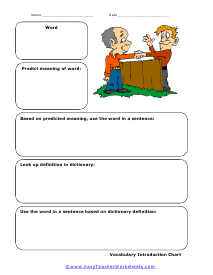Printable Vocabulary Graphic Organizers
Click the buttons to print each organizer.

Vocabulary Concept Chart
This sheet allows a core word or concept to be listed, with characteristics and dissimilarities noted.

Builder Chart
Asks for a definition, part of speech label, synonyms and antonyms, sentence usage, and illustration.

New Words Chart
This sheet asks for the same information as the page above, but in a slightly different layout.

Vocabulary Builder Chart 3
This sheet asks for the same information as the page above, but in a slightly different layout.

Using Pictures With New Words
While more focused on the artistic side, this worksheet also has space for an etymology.

Introduction Chart
This sheet challenges students to derive definitions of new vocabulary words from context clues.
How to Use Graphic Organizers to Learn New Vocabulary
As students grow, they learn new words. They need to understand the correct meaning of each word. While some students find it easy to find the meanings of new words, others struggle based on their lack of interest. However, teachers can spark interest in learning new vocabulary among the students. There are many ways to improve vocabulary. Graphic organizers are beneficial to accomplishing this goal.
If you are a mother or a teacher looking for ways to improve your kid's vocabulary, we have a few methods that can help you. Let's have a look.
Ways to Learn Vocabulary Using Graphic Organizers
Graphical charts can play an influential role in enhancing a student's knowledge. You can use them to teach anything. Today, we will look into a few types of graphical charts to enhance vocabulary learning.
KWL Charts
KWL stands for Know, Want to Know, and Learned. You can use this chart to help your kids learn new words with their meanings. There are many ways you can organize information in the KWL charts for your kids or students.
For example, you can start by helping your students brainstorm about certain words they already know. Mention the words in the "Know" column. To help them learn a new word, you can think of a few synonyms of the exact words. By writing the synonymous terms in the "Want to know" column, you can help them associate the meaning with the new words.
By going over a few words following the same pattern, you can test them with their learning. Once learned, you can add the meaning to the "Learned" column. It would be great if your students could keep individual KWL charts to go over the new words independently.
Word Maps
Using word maps to enhance your students' vocabulary can be a great idea. You can pick new words and break them down into different parts. Your students may be able to learn a new word. However, to ensure they understand the meaning and use of the word correctly, you may need to create a word map.
You can associate examples, antonyms, synonyms, and visual aids to help your students learn the word with the correct meaning. This method is an exciting way to induce interest in learning vocabulary among kids.
There are different ways to create a word map. You can opt for any method you like. For example, you can place a word in the middle, surrounded by boxes containing different elements mentioned above.
Analogy Chart
One of the most effective ways to learn vocabulary using graphical charts is by creating an analogy chart. Students can find a connection with different words by understanding their meanings correctly. You can place the vocabulary words on the left side of the analogy chart. You may ask your students to find a relation with the listed terms and mention it in the next column.
For example, if you teach your students to learn the word "Spectacle," you can list the word in the first column and share the meaning with your students. Now, those who wear spectacles can describe their connection with the word in the next column by writing, "I wear spectacles."
Similarly, those students who do not wear spectacles can write, "I do not wear spectacles." This activity aims to help your kids or students learn the correct meaning of the word.
The above-listed methods to learn vocabulary can help your kids or students to engage in learning activities. Teachers typically use these methods to help students improve their word knowledge. You may use other ways to create graphic organizers to enhance your students' learning.
How to Keep a Vocabulary Journal
The English language is filled with thousands of words. And as you the language progresses each day and the language prodigies discover new words, the dictionary keeps filling up. If you want to increase your vocabulary or make sure that you have a great command over the English language, then how about keeping a vocabulary journal?
To maintain a vocabulary journal, you can do the following: Read books and then mark the words that intrigue you. Take another notebook and write down the words in one column. Now look up for their meanings in the dictionary and then write them in a separate column. Make sure to keep this vocabulary journal updated at all times.
With this journal in your hand, you will have your own dictionary filled with thousands of words. Make sure to keep it appealing and colorful so that it attracts you to write more words.

